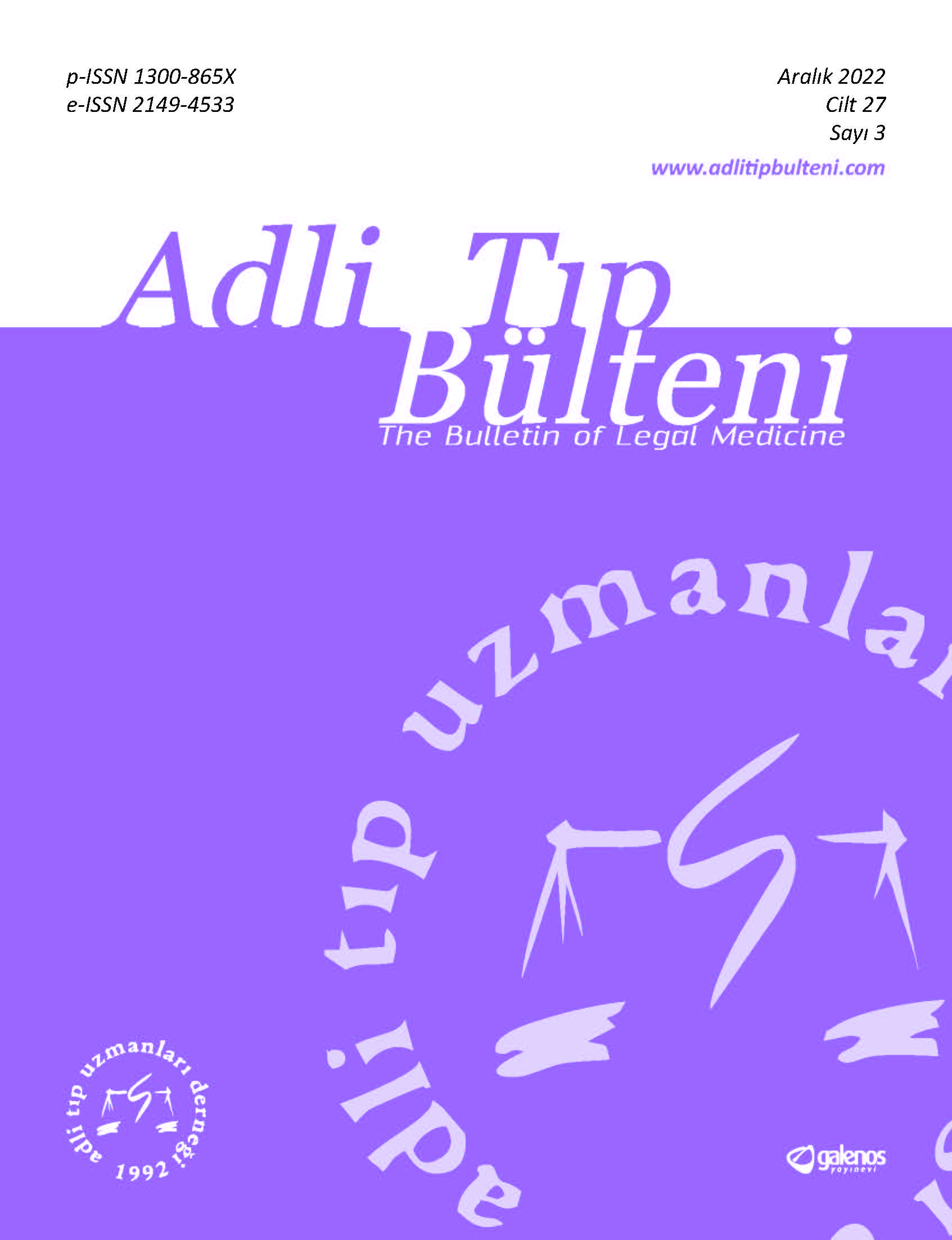Abstract
Objective: It is aimed to reveal the demographic characteristics of patients who died due to non-traumatic aortic dissection, the findings that will increase the risk of aneurysm and dissection, and the complications that develop after dissection, in the light of histopathological findings.
Methods: 138 cases diagnosed with non-traumatic aortic dissection, whose autopsies were performed between 2014 and 2018, were retrospectively analyzed. Age and gender distribution, body mass index, distribution of dissection types, complications that may develop after dissection in organs, and histopathological changes in the aortic wall were evaluated.
Results: Cardiac tamponade was detected in 67.4% (n=93) of the cases, tamponade and hemothorax in 15.9% (n=22) and hemothorax in 11.6% (n=16). 5.1% (n=7) had a bicuspid aortic valve. 28.2% (n=39) had atherosclerosis, 21.7% (n=30) had elastic degeneration, and 10.8% (n=15) had cystic medial necrosis. In 55.8% (n=77), pathological changes in the vessel wall were not reported. There was widespread intraalveolar bleeding in 34.8% (n=48) and focal intraalveolar hemorrhage in 6.5% (n=9). When cardiac findings were examined, myocardial infarction was observed in 2.2% (n=3).
Conclusion: In cases of aortic dissection, a detailed macroscopic and microscopic examination should be performed together with the clinical history. Histopathological examination of the dissected area is important in demonstrating the underlying factors. Histopathological findings in the organs may be useful in predicting the complications of the disease. Autopsy has a critical importance not only in recognizing and understanding the disease, but also in determining the treatment methods to be applied for the disease.
References
Doğan KH, Demirci Ş, Doğan NÜ, Gülmen MK. Torasik aort anevrizma rüptürüne bağlı ölümlerin değerlendirilmesi, Türkiye Klinikleri J Foren Sci Leg Med 2014:11(1);1-6.
Evangelista A, Teixidó-Tura G. Sudden Cardiovascular Death in Young Patients With Aortic Dissection. What Lessons Should We Learn? Rev Esp Cardiol (Engl Ed). 2019; 72(7):528-530. https://doi.org/10.1016/j.rec.2019.01.010
Meszaros I, Morocz J, Szlavi J, Schmidt J, Tornóci L, Nagy L, et al. Epidemiology and clinicopathology of aortic dissection. Chest. 2000;117:1271–1278. https://doi.org/10.1378/chest.117.5.1271
Clouse WD, Hallett JW Jr, Schaff HV, Spittell PC, Rowland CM, Ilstrup DM, et al. Acute aortic dissection: population based incidence compared with degenerative aortic aneurysm rupture. Mayo Clin Proc. 2004;79:176–180. https://doi.org/10.4065/79.2.176
Olsson C, Thelin S, Ståhle E, Ekbom A, Granath F. Thoracic aortic aneurysm and dissection: increasing prevalence and improved outcomes reported in a nationwide population-based study of more than 14,000 cases from 1987 to 2002. Circulation. 2006;114(24):2611-8. https://doi.org/10.1161/CIRCULATIONAHA.106.630400
Landenhed M, Engström G, Gottsäter A, Caulfield MP, Hedblad B, Newton-Cheh C, et al. Risk profiles for aortic dissection and ruptured or surgically treated aneurysms: a prospective cohort study. J Am Heart Assoc. 2015:21;4(1):e001513. https://doi.org/10.1161/JAHA.114.001513
Huynh N, Thordsen S, Thomas T, Mackey-Bojack SM, Duncanson ER, Nwuado D, et al. Clinical and pathologic findings of aortic dissection at autopsy: Review of 336 cases over nearly 6 decades. Am Heart J. 2019;209:108-115. https://doi.org/10.1016/j.ahj.2018.11.006
Dokgöz H, Bütün C, Berber C. Dissekan aorta anevrizma rüptürüne bağlı ölümlerin değerlendirilmesi. Adli Tıp Dergisi 2003;17(3-4): 25-29
Subramaniam K, Sheppard MN. Thoracic aortic dissection. Death may not always be due to rupture with haemorrhage. Unusual complications which can be missed at autopsy. J Forensic Leg Med. 2018;54:127-129. https://doi.org/10.1016/j.jflm.2018.01.005
İlkeli E. Non-Travmatik Acil Aort Patolojilerinin Değerlendirilmesi:Tek Merkezli Retrospektif Araştırma. Balıkesir Medical Journal. 2020;4(3): 13-18. https://doi.org/10.33716bmedj.750002
Güven FM, Korkmaz İ, Doğan Z, Döleş KA, Eren ŞH. Akut aort diseksiyonu: Atipik başvurular. Türkiye Acil Tıp Dergisi. 2009;9(2);79-83.
Shimizu T, Kimura N, Mieno M, Hori D, Shiraishi M, Tashima Y, Yuri K et al. Effects of Obesity on Outcomes of Acute Type A Aortic Dissection Repair in Japan. Circ Rep. 2020;2(11):639-647. Published 2020 Oct 23. doi:10.1253/circrep.CR-20-0098
Pál D, Szilágyi B, Berczeli M, Szalay CI, Sárdy B, Oláh Z, et al. Ruptured Aortic Aneurysm and Dissection Related Death: an Autopsy Database Analysis. Pathol Oncol Res. 2020;26(4):2391-2399. https://doi.org/10.1007/s12253-020-00835-x
Makrygiannis G, Courtois A, Drion P, Defraigne JO, Kuivaniemi H, Sakalihasan N. Sex differences in abdominal aortic aneurysm: the role of sex hormones. Ann Vasc Surg. 2014;28(8):1946-58. https://doi.org/10.1016/j.avsg.2014.07.008
Villard C, Swedenborg J, Eriksson P, Hultgren R. Reproductive history in women with abdominal aortic aneurysms. J Vasc Surg. 2011;54(2):341-5. https://doi.org/10.1016/j.jvs.2010.12.069
Villard C, Eriksson P, Kronqvist M, Lengquist M, Jorns C, Hartman J, et al. Differential expression of sex hormone receptors in abdominal aortic aneurysms. Maturitas. 2017;96:39-44. https://doi.org/10.1016/j.maturitas.2016.11.005
Ladich E, Butany J, Virmani R. Aneurysms of the Aorta: Ascending, Thoracic and Abdominal and Their Management. Içinde: Maximilian Buja L, Butany J, editörler. Cardiovascular pathology. 4. baskı London: Elsevier; 2016. s. 194–200.
Ward C. Clinical significance of the bicuspid aortic valve. Heart 2000;83: 81-5. https://doi.org/10.1136/heart.83.1.81
Nistri S, Sorbo MD, Marin M, Palisi M, Scognamiglio R, Thiene G. Aortic root dilatation in young men with normally functioning bicuspid aortic valves. Heart 1999;82: 19-22. https://doi.org/10.1136/hrt.82.1.19
Roberts CS, Roberts WC. Aortic dissection with the entrance tear in the descending thoracic aorta. Analysis of 40 necropsy patients. Ann Surg 1991;213(4):356–68. https://doi.org/10.1097/00000658-199104000-00011
Schlant RC, Alexander RW. Diseases of the great vessels and peripheral vessels. Hurst’s The Heart. 8. baskı. New York: McGraw-Hill; 1994. s.1440-7.
Subramaniam K, Sheppard MN. Thoracic aortic dissection. Death may not always be due to rupture with haemorrhage. Unusual complications which can be missed at autopsy. J Forensic Leg Med. 2018;54:127-129. https://doi.org/10.1016/j.jflm.2018.01.005
Ioachimescu OC, Stoller JK. Diffuse alveolar hemorrhage: diagnosing it and finding the cause. Diffuse alveolar hemorrhage: diagnosing it and finding the cause. Cleve Clin J Med 2008;75:258. https://doi.org/10.3949/ccjm.75.4.258
Akgedik R, Karamanlı H, Günaydın Yüksel Z, Uzun K. A rare cause of diffuse alveolar hemorrhage: dissection of aorta. Turk Gogus Kalp Dama 2017;25:147-150. https://doi.org/10.5606/tgkdc.dergisi.2017.13024
Sueyoshi E, Matsuoka Y, Sakamoto I, Uetani M. CT and clinical features of hemorrhage extending along the pulmonary artery due to ruptured aortic dissection. Eur Radiol. 2009;19:1166–1174. https://doi.org/10.1007/s00330-008-1272-7
Roberts WC. Aortic dissection: anatomy, consequences, and causes. Am Heart J. 1981;101:195–2. https://doi.org/10.1016/0002-8703(81)90666-9

This work is licensed under a Creative Commons Attribution 4.0 International License.
Copyright (c) 2022 The Bulletin of Legal Medicine

